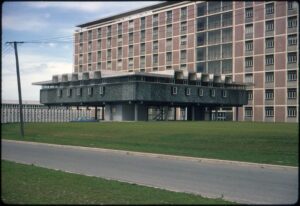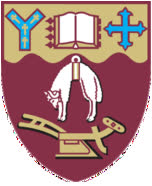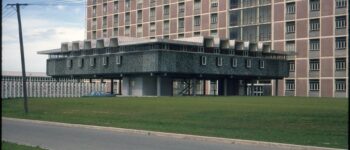1967: Physical Sciences Library
February 6, 2023
By AHNZ

The long history of the University of Canterbury’s libraries resembles the life cycle of a star.
The dust of assorted papers and books grew by accretion into a nebula of bibliographic material. Initially the collection had no central mass but floated about in academic space as a tiny collection for 43 years locked in glass cases in hallways. The particulate matter gathered very slowly so that 12 years after the founding of Canterbury College the tiny collection had doubled, and after 7 more years doubled again. A small protostar of a library formed in a gloomy little room under the Wooster Street clock tower in 1916.
Christchurch’s public library was not owned or controlled by the people or the city but by Canterbury College. When, in 1916, the protostar library started pulling matter in from the public library the College explained why and assured the public that they were welcome to visit and borrow at both locations. After 75 years of College history the collection reached 100,000 volumes.
In 1961 the University of Canterbury broke free of the government monopoly, The University of New Zealand. In doing so, it physically re-located to a new campus at Ilam and, of course, the library collection followed even while it was exploding. The library star underwent fission, forming two binary stars, then split and split again until there were many multiple libraries distributed around the campus orbited by various Special Collections.
In the best of times Canterbury University could boast 6 full specialist libraries complete with collections, staff, computers, and study space. I used to study in every single one and they were all exciting and welcoming with their own energy.
The Library was first established at Canterbury College in 1879. Initially the collection grew very slowly and it was three-quarters of a century before the first 100,000 volumes were acquired. But since then there has been real and rapid growth…The College was founded in 1873, but there was no real home for the tiny collection of books for 43 years. They were locked in glass cases in the hall initially and were later moved to a gloomy little room under the Worcester Street clock tower.” – Introduction to the University of Canterbury Library, Canterbury University (1998,) Wayback Machine
“The first library building was ready for use in 1916. With the move to the Ilam campus, the Library was split. First the Engineering Library, and later the Physical Sciences Library, moving to the new campus. Finally, in 1974, the rest of the Library moved to the Ilam campus and was housed in the newly constructed James Hight building (now known as Puaka-James Hight).” – History of the UC Library, University of Canterbury (2023)
“The new College library is being furnished at present, and it is hoped to open it in time for the beginning of the March term…the city has no municipally owned library. The present public library… has been controlled by Canterbury College since its foundation..” – BOOKS FOR THE COLLEGE A HARMLESS TRANSFER, Star (1916,) Papers Past
“The new School of Science at Ilam will be ready for use by the University of Canterbury next year. This assurance from all three contractors, received yesterday, was “the best news the university has received this year,” the Vice-Chancellor (Dr. L. L. Pownall) told the University Council…Dr. Pownall read a letter from the district architect of the Ministry of Works (Mr P. C. Cornish) giving the assurances from the W. Williamson Construction Company, Ltd., chemistry and physics block and physical sciences library…” – School Of Science Ready Next Year, Press (1966,) Papers Past
“The new sciences library of the University of Canterbury which fronts on to Ham road, attracts attention by its elevated construction, its , unusual roof, and colourful facing of deep green aggregate chips. It is now in use by staff and research… workers and ready for the big influx of students at the end of the month.”
“There is also a small rare books room, also containing theses and expedition reports. The sciences library now has a complete catalogue of all works stored there and in the basement stack. This was a big job in itself, involving the withdrawal of cards from the university’s master catalogue, making duplicates, returning the main entry cards,… At the entrance there is a room for coats and satchels and a large reception and issuing area. Readers may then move round the four sides of the hollow square which looks down on to the ground-level central court. Exterior walls are solid with green-granite facing and shelves of books internally. There is floor-to-ceiling glass looking inward down on the court. ” – Library in Use, Press (Feb 1967,) Papers Past
“They thought the Library was a dangerous place because of all the magical books, which was true enough, but what made it really one of the most dangerous places there could ever be was the simple fact that it was a library.” – Terry Pratchett
 The Physical Sciences Library (image, top,) was just one of the many libraries in that multi-stellar system that has now receded. To my surprise, it started out life as a sort of floating building back in the late 1960s! Up-top was for the library and the lower floor was later filled in (probably in the 1980s) and added to satiate the hunger for space. Now I can see why there were what seemed ill-placed pillars in the way on the ground floor or this library. I remember now there was a mysterious central alcove on the ground that you looked down on and in on. A sort of garden. So, the dreams of the architect certainly took a hit on this grand design. (Happens all the time. Ayn Rand could write a novel about that.)
The Physical Sciences Library (image, top,) was just one of the many libraries in that multi-stellar system that has now receded. To my surprise, it started out life as a sort of floating building back in the late 1960s! Up-top was for the library and the lower floor was later filled in (probably in the 1980s) and added to satiate the hunger for space. Now I can see why there were what seemed ill-placed pillars in the way on the ground floor or this library. I remember now there was a mysterious central alcove on the ground that you looked down on and in on. A sort of garden. So, the dreams of the architect certainly took a hit on this grand design. (Happens all the time. Ayn Rand could write a novel about that.)
This library had its own library staff, toilets, computers. Lots of books and journals. Lots of study spots. Catalogues. Specilised in Astronomy, Chemistry, Computer Science, Mathematics and Statistics and Physics. Display of the latest science books. A flying bridgeway linking up with the Rutherford science building towering over the library. There was frequently a special display of new books. A display featuring an issue in the sciences, eg. Moon Landing Fake or Not? There were indications of rooms in that top floor that appeared to be permanently locked; What was in there? Research indicates these would have been the old Rare Books room or the Cloak Room where our now-gone high-trust/high Social Capital society could leave valuables unguarded and collect them later.
Central Library: The Central Library is located in the James Hight building opposite the Registry. It houses the Humanities, Commerce, Social, Biological & Geological Sciences, Music/Fine Arts & Antarctic collections.Engineering Library: The Engineering Library is situated in the School of Engineering on the north side of campus, & holds the collections of the School of Engineering and the School of Forestry (the latter probably had its own library prior. Cannot confirm.)
Law Library: As well as legal material, the library holds New Zealand parliamentary publications. The Law Library occupies level two and three of the Law School building. Open access to all the subscription databases such as the records of trials and case law that usual civilians can never reach.
Macmillan Brown Library: The Macmillan Brown Library is the University of Canterbury’s research collection of New Zealand and Pacific Islands materials. It is located in Te Ao Mārama: the Māori and Pacific Studies Building.
Physical Sciences Library: The Physical Sciences Library houses the Computer Science & Software Engineering, Mathematics & Statistics, Physics & Astronomy and Chemistry collections. It is located beside the Rutherford Building for Physics and Chemistry.
Music and Fine Arts Collection library: Audio/visual library and the means to play the media. Serials, restricted loans, theses, restricted access books and files, new book display,…a library on its own floors of the Central Library. Ref. MFA (1998), Wayback Machine
Fine Arts Library: I don’t know what this was properly called. It occupied part of Fine Arts Block 1 on Arts Road. Modest study space but huge central areas to spread out into. Unique vibe. Echos armies of your Hippy high school art teachers having passed through it and wiffs of Alister Taylor (or what I think his publications would smell like.)
Henry Field Library, Christchurch College of Education (est. 1877:) Materials specific to an education library. Became a formal part of the University of Canterbury in 2007 and was promptly deleted.
You really could flit between all of these places and try them out for size. It was a physical space to tap into the different parts of the personalities we all have inside and help open up the sleeping ones. The Law Library was bright and formal, a place to straighten your back and behave. Central Library was a place you could easily hide at some forgotten desk or secret shelf while wondering how 1870s copies of Leviathan were there for the touching and reading and taking by the likes of us. I’ve been back to look and vintage books like that are gone now. Macmillan Brown was a good library for me to read parliamentary Hansard in hardcopy, finding books about New Zealand, reading The Free Radical and Jane Cliffton’s bit in The Listener. Engineering felt a bit intimidating with hustle and bustle of practicality; Build it, get it done, stop dreaming and intellectualising! These different curations and collections had a distinctiveness that cannot be replaced by the centralisation down to 3 libraries or by the expectation we’re all consuming information on the screens of our phones or laptops.
These library stars started to collapse in on themselves around the central mass of the Central Library in the James Height building. The Christchurch Earthquake of 2011 was a catalyst for University Administration to do what it wanted to do which was to consolidate the libraries and curtail the liability of maintaining library resources. Hungry for office space, they would rather re-task these buildings to places they could charge students for. So, as well as expanding outward into Ilam by gobbling up houses the University was expanding inwards by autocannibalism. The library stellar system is on the verge of being a Black Hole now and collapsing in on itself completely.
It’s a surprise that even the Law Library has gone. But, I’m sure, even the Law Facility must have been persuaded by the lust for filling those 2 luxurious floors up with cells and offices of paying customers. Even the basement level of the Central Library, once bicycle racks, has been converted into classroom and study spaces! The next library to go will probably be the Macmillan Brown Library. Despite owing its namesake everything (Brown a massive donor and academic contributor) it’s not Politically Correct to think or repeat or even to know many of the ideas that John Brown held, especially about Maoris. The same can be said for James Height whose building has been re-branded for the Aotearoa New Zealand era as Puaka-James Hight while Te Puna Rakahau o Macmillan Brown thinly obscures the un-investigated legacy of the other great man. The policy appears to be to not ask too many questions for now. But when the next library gets sucked into what is now a Black Hole System the pretense will probably be that Brown (born in 1845 for goodness sake!) was “racist” and lacked “diversity.”
—
1 Ref. Campus Libraries, University of Canterbury (1998,) Wayback Machine
University of Canterbury, December 1967. From a Kodachrome slide. Dave Murray, Remembering Christchurch, Facebook (2023)
 Like Comment Share
Like Comment Share





